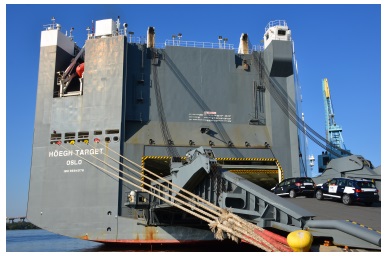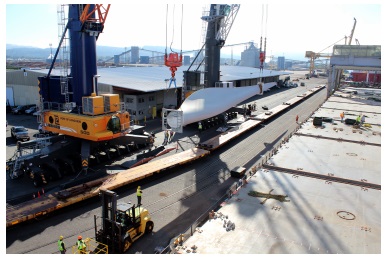Cargo Operations: Jacksonville, Longview
![]() Print this Article | Send to Colleague
Print this Article | Send to Colleague
JAXPORT welcomes world's largest Pure Car and Truck Carrier

Höegh Target, the world’s largest Pure Car and Truck Carrier, loading autos at JAXPORT’s Blount Island Marine Terminal
Photo/JAXPORT
The Jacksonville Port Authority (JAXPORT) recently welcomed the world’s largest Pure Car and Truck Carrier (PCTC), to Blount Island Marine Terminal. The Höegh Target, which an carry up to 8,500 car equivalent units (CEU) arrived in Jacksonville via the newly expanded Panama Canal locks. PCTCs can accommodate all types of rolling stock, from fully assembled passenger cars and pickup trucks to construction machinery.
Höegh Target is the first in a series of six post-Panamax PCTCs Höegh is adding to its fleet. With a beam 36.5 meters/119.8 feet, the vessels are too wide to transit the old Panama Canal locks. The extra width increases the ship’s capacity by 700 CEUs.
Jacksonville is one of the nation’s busiest vehicle handling ports, with volume last year of nearly 657,000 units.
Longview: Wind cargo Discharged Directly from Ship to Rail

Longview claims to be the is the first known port in the United States to discharge wind energy blades directly from vessel to rail.
Utilizing the port’s mobile harbor cranes in tandem, the 160-foot blades were discharged to flatbed rail cars adjacent the vessel, moving along the port’s on-dock rail system. Each blade required two rail cars. Members of the International Longshore and Warehouse Union (ILWU) secured the blades to the cars.
The initial shipment of 60 blades arrived in mid-July aboard the Saga Frigg, which discharged 12 blades directly to rail as a test. The CP Atlantic delivered the second shipment in August 150 blades stacked five high. In this case, 30 blades were loaded on a unit train and the rest went to a yard for subsequent loading on rail cars and trucks. All 60 blades in the most recent shipment were unloaded directly to two full unit trains from M/V CP Kraszewski.
Vestas manufactured the blades in China for a wind energy farm in Illinois. The Vestas blade unit trains consist of 60 cars, or 1 blade for every 2 cars, and are 5,700 feet in length.
"Strategic investments in both equipment and rail, combined with an experienced labor force, have made the Port of Longview a leader in breakbulk cargo handling," said the Port Business Development Manager Laurie Nelson-Cooley. "Executing this ground breaking operation really emphasizes our capabilities to our customers."

